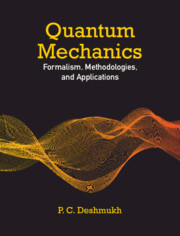Book contents
- Frontmatter
- Dedication
- Contents
- List of Figures
- Foreword
- Preface
- 1 Description of a Physical System
- 2 Path Integral Formulation of Quantum Mechanics
- 3 Probability Tangles and Eigenstates of One-dimensional Potentials
- 4 Angular Momentum
- 5 The Non-relativistic Hydrogen Atom
- 6 Approximation Methods
- 7 The Relativistic Hydrogen Atom
- 8 Quantum Mechanics of Spectral Transitions
- 9 The Many-Electron Atom
- 10 Quantum Collisions
- 11 Introduction to Quantum Information and Quantum Computing
- Appendix A Symmetry of the Hamiltonian
- Appendix B Schrödinger, Heisenberg, and Dirac “Pictures” of Quantum Dynamics
- Appendix C Spherical Harmonics
- Appendix D Occupation Number Formalism Second Quantization
- Appendix E Electron Structure Studies with Qubits
- Index
9 - The Many-Electron Atom
Published online by Cambridge University Press: 14 September 2023
- Frontmatter
- Dedication
- Contents
- List of Figures
- Foreword
- Preface
- 1 Description of a Physical System
- 2 Path Integral Formulation of Quantum Mechanics
- 3 Probability Tangles and Eigenstates of One-dimensional Potentials
- 4 Angular Momentum
- 5 The Non-relativistic Hydrogen Atom
- 6 Approximation Methods
- 7 The Relativistic Hydrogen Atom
- 8 Quantum Mechanics of Spectral Transitions
- 9 The Many-Electron Atom
- 10 Quantum Collisions
- 11 Introduction to Quantum Information and Quantum Computing
- Appendix A Symmetry of the Hamiltonian
- Appendix B Schrödinger, Heisenberg, and Dirac “Pictures” of Quantum Dynamics
- Appendix C Spherical Harmonics
- Appendix D Occupation Number Formalism Second Quantization
- Appendix E Electron Structure Studies with Qubits
- Index
Summary
It may well be that the high-speed digital computer will have as great an influence on civilization as the advent of nuclear power.
—Douglas R. HartreeStatistics is intrinsic to quantum theory. Description of nature requires it. In classical physics, we take recourse to statistical analysis either when we are not interested in a detailed solution, or when we are unable to cope up with a large amount of data. Statistical methods enable us to extract important and useful information about the system to understand its physical properties. For example, rather than keeping track of kinetic energies of individual molecules, we determine their average, and benefit from the notion of temperature. The great debate between Albert Einstein and Niels Bohr in the late 1920s and in the 1930s eventually established (especially after the work of John Bell in 1964, discussed in Chapter 11) that the role of statistics in describing nature is far deeper than was suspected earlier. Statistics must be invoked to describe physical properties of nature even when we are dealing with a single particle, or for that matter even vacuum. In this chapter, we study another important manifestation of the role of statistics in quantum theory; this comes from the identity of particles in nature.
9.1 Symmetry Properties of Wavefunctions for Bosons and Fermions
If we have ten electrons, classical physics would regard the particles as distinguishable; the ten electrons could be numbered from one through ten, and one could, at least in principle, follow the dynamics of a particular, say the seventh, electron. Electrons are fundamental particles in nature. They are not amenable to their description by classical statistics. They must be described by quantum theory. In an N-electron system, it is impossible to tag any of these electrons by a number, such as the seventh. This impacts how the electrons occupy energy levels available to them.
The smallest many-particles system is a pair of identical particles. If we subject the pair of particles to an interchange, effected by the operator, and then interchange them yet again, we must get the original state. We expect the double interchange to be the identity operator. We therefore write
where the two-particle state is represented by, with representing the coordinates of the two particles. These coordinates would include not only the three space coordinates but also the spin coordinate.
- Type
- Chapter
- Information
- Quantum MechanicsFormalism, Methodologies, and Applications, pp. 411 - 450Publisher: Cambridge University PressPrint publication year: 2024



